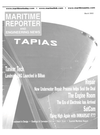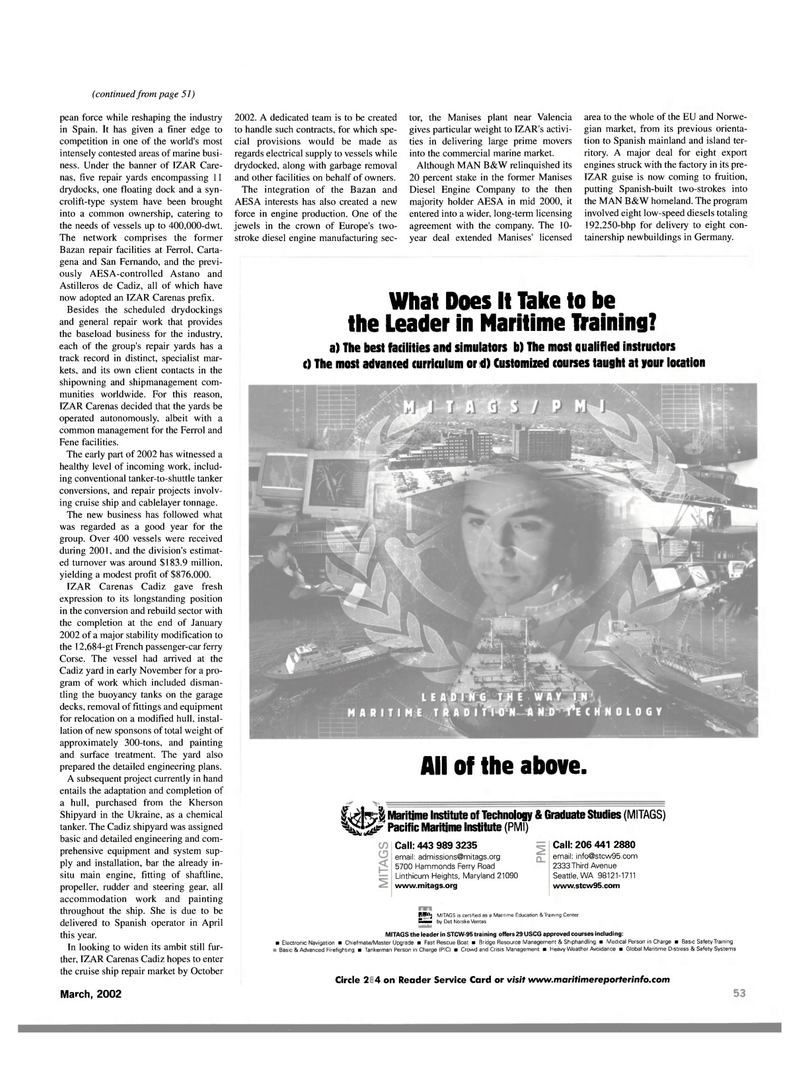
Page 53: of Maritime Reporter Magazine (March 2002)
Read this page in Pdf, Flash or Html5 edition of March 2002 Maritime Reporter Magazine
(continued from page 51) pean force while reshaping the industry in Spain. It has given a finer edge to competition in one of the world's most intensely contested areas of marine busi- ness. Under the banner of IZAR Care- nas, five repair yards encompassing 11 drydocks, one floating dock and a syn- crolift-type system have been brought into a common ownership, catering to the needs of vessels up to 400,000-dwt.
The network comprises the former
Bazan repair facilities at Ferrol, Carta- gena and San Fernando, and the previ- ously AESA-controlled Astano and
Astilleros de Cadiz, all of which have now adopted an IZAR Carenas prefix.
Besides the scheduled drydockings and general repair work that provides the baseload business for the industry, each of the group's repair yards has a track record in distinct, specialist mar- kets, and its own client contacts in the shipowning and shipmanagement com- munities worldwide. For this reason,
IZAR Carenas decided that the yards be operated autonomously, albeit with a common management for the Ferrol and
Fene facilities.
The early part of 2002 has witnessed a healthy level of incoming work, includ- ing conventional tanker-to-shuttle tanker conversions, and repair projects involv- ing cruise ship and cablelayer tonnage.
The new business has followed what was regarded as a good year for the group. Over 400 vessels were received during 2001, and the division's estimat- ed turnover was around $183.9 million, yielding a modest profit of $876,000.
IZAR Carenas Cadiz gave fresh expression to its longstanding position in the conversion and rebuild sector with the completion at the end of January 2002 of a major stability modification to the 12,684-gt French passenger-car ferry
Corse. The vessel had arrived at the
Cadiz yard in early November for a pro- gram of work which included disman- tling the buoyancy tanks on the garage decks, removal of fittings and equipment for relocation on a modified hull, instal- lation of new sponsons of total weight of approximately 300-tons, and painting and surface treatment. The yard also prepared the detailed engineering plans.
A subsequent project currently in hand entails the adaptation and completion of a hull, purchased from the Kherson
Shipyard in the Ukraine, as a chemical tanker. The Cadiz shipyard was assigned basic and detailed engineering and com- prehensive equipment and system sup- ply and installation, bar the already in- situ main engine, fitting of shaftline, propeller, rudder and steering gear, all accommodation work and painting throughout the ship. She is due to be delivered to Spanish operator in April this year.
In looking to widen its ambit still fur- ther, IZAR Carenas Cadiz hopes to enter the cruise ship repair market by October
March, 2002 55 2002. A dedicated team is to be created to handle such contracts, for which spe- cial provisions would be made as regards electrical supply to vessels while drydocked, along with garbage removal and other facilities on behalf of owners.
The integration of the Bazan and
AESA interests has also created a new force in engine production. One of the jewels in the crown of Europe's two- stroke diesel engine manufacturing sec- tor, the Manises plant near Valencia gives particular weight to IZAR's activi- ties in delivering large prime movers into the commercial marine market.
Although MAN B&W relinquished its 20 percent stake in the former Manises
Diesel Engine Company to the then majority holder AESA in mid 2000, it entered into a wider, long-term licensing agreement with the company. The 10- year deal extended Manises' licensed area to the whole of the EU and Norwe- gian market, from its previous orienta- tion to Spanish mainland and island ter- ritory. A major deal for eight export engines struck with the factory in its pre-
IZAR guise is now coming to fruition, putting Spanish-built two-strokes into the MAN B&W homeland. The program involved eight low-speed diesels totaling 192,250-bhp for delivery to eight con- tainership newbuildings in Germany.
L^rs) Maritime Institute of Technology & Graduate Studies (MITAGS) ^SJr Pacific Maritime Institute (PMI)
Call: 443 989 3235 email: [email protected] 5700 Hammonds Ferry Road
Linthicum Heights, Maryland 21090 www.mitags.org
Call: 206 441 2880 email: [email protected] 2333Third Avenue
Seattle, WA 98121-1711 www.stcw95.com
RffW] MITAGS is certified as a Maritime Education & Training Center
EMM by Det Norske Veritas
MITAGS the leader in STCW-95 training offers 29 USCG approved courses including: • Electronic Navigation • Chiefmate/Master Upgrade • Fast Rescue Boat • Bridge Resource Management & Shiphandling • Medical Person in Charge • Basic Safety Training
Basic & Advanced Firefighting • Tankerman Person in Charge (PIC) • Crowd and Crisis Management • Heavy Weather Avoidance • Global Maritime Distress & Safety Systems
Circle 254 on Reader Service Card or visit www.maritimereporterinfo.com
What Does It Take to be the Leader in Maritime Training? a) The best facilities and simulators b) Ihe most qualified instructors c) Ihe most advanced curriculum or d) Customized couraes taught at youi location
All of the above.

 52
52

 54
54
